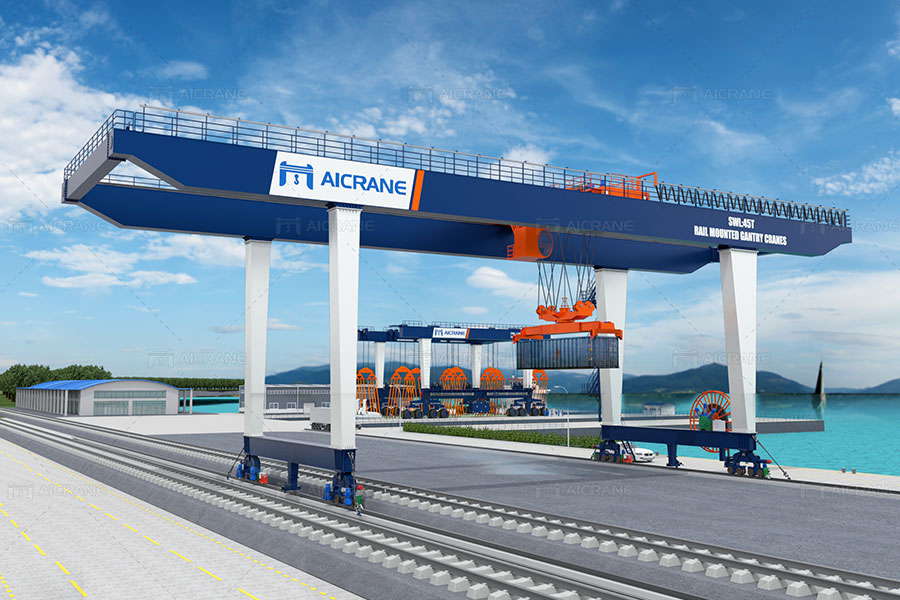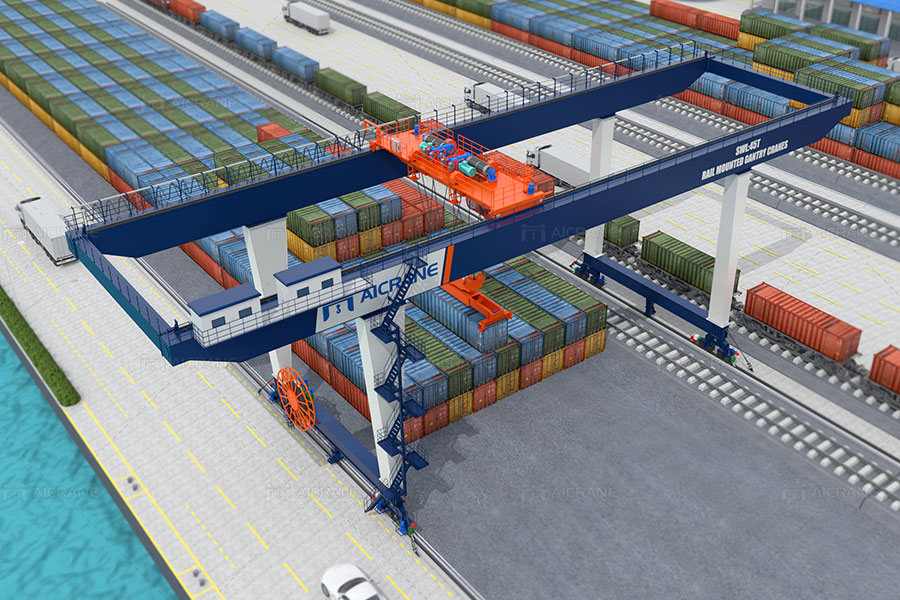When it comes to designing and selecting container gantry cranes, one of the most crucial factors that must be considered is the environment in which the cranes will operate. The environmental conditions at a port, warehouse, or industrial site can significantly affect the specifications, features, and performance of the cranes. These conditions include temperature variations, humidity levels, wind speeds, corrosive elements, seismic activity, and more. Understanding how these environmental factors influence crane operations and specifications is essential for optimizing crane performance, extending service life, and ensuring safety.
In this article, we will explore how various environmental conditions impact the specifications of container handling gantry crane, including their design, materials, maintenance requirements, and safety features.

1. Temperature Variations
Temperature is one of the most common environmental factors that influence the performance and durability of container gantry cranes. Temperature fluctuations—whether extreme heat or cold—can affect the operation of critical components like motors, cables, bearings, and hydraulic systems. Here’s how temperature variations impact container gantry cranes:
High Temperatures
In regions with high ambient temperatures, cranes may experience overheating of electrical components or hydraulic systems. This can lead to reduced efficiency, overheating of electrical circuits, or even system failures. Gantry crane manufacturers often design cranes for hot climates with additional cooling mechanisms, such as fans or heat exchangers, to prevent overheating. Moreover, materials used for the crane’s structure and components must be capable of withstanding high heat, so aluminum, galvanized steel, or stainless steel may be used for corrosion resistance.
Low Temperatures
Conversely, in colder climates, cranes must be designed to cope with freezing conditions. Hydraulic fluids can become thicker in colder temperatures, potentially affecting crane operation. To counter this, crane systems may incorporate low-temperature lubricants and heaters for hydraulic components. Furthermore, electrical systems must be insulated to prevent freezing of wiring and control circuits. Cold-resistant materials and coatings also play a crucial role in preventing brittleness and cracking in crane structures during winter months.
2. Humidity and Corrosive Environments
The impact of humidity and exposure to corrosive elements, such as salt in coastal regions, can be substantial. Humid or saline environments pose challenges to crane materials and components, leading to faster corrosion, rust, and degradation over time. This can reduce the structural integrity of the crane and impact its safety and reliability.
Corrosion Resistance
In environments where cranes are exposed to high levels of humidity or corrosive substances like saltwater (common in port areas), manufacturers must use specialized materials that can resist corrosion. Stainless steel, galvanized steel, and anti-corrosion coatings are typically used for crane parts, such as beams, girders, and cables. Cranes operating in marine environments may also be equipped with additional protective coatings, such as epoxy or polyurethane paints, to ensure the longevity of components.
Humidity Considerations
Humidity can also affect electrical components and wiring inside the crane. To mitigate the risk of electrical failures, crane manufacturers may install sealed enclosures for electrical systems to protect them from moisture. Additionally, crane components like bearings, motors, and control panels may have special seals or gaskets to prevent the ingress of water or moisture, which could lead to malfunction or short circuits.

3. Wind Speeds and Storm Conditions
Wind and storm conditions can be a significant factor in crane design, particularly for outdoor gantry cranes used in open spaces such as ports and terminals. Container gantry cranes are large and tall structures, and strong winds can affect their stability and performance. High wind speeds can influence lifting operations, crane movements, and even the safety of workers.
Wind Load Calculations
In regions that experience strong winds or frequent storms, container gantry cranes are often designed with wind load considerations in mind. The crane structure must be engineered to withstand wind forces without compromising its safety or operational capacity. Engineers calculate the maximum expected wind load for a given region and use this data to ensure that the crane’s tower, arms, and gantry are designed with enough structural integrity to handle these forces.
Wind Speed Limitations
Additionally, crane operators must consider the wind speed limits for safe crane operation. In extreme conditions, cranes may be equipped with sensors that detect wind speed, automatically limiting or halting operations when the wind exceeds a safe threshold. Some cranes may also feature anti-sway systems to counteract the effects of wind on the load being lifted, reducing the risk of load shifting or accidents.
4. Seismic Activity
Earthquakes or seismic events can significantly impact the design and operation of container gantry cranes, particularly in regions where seismic activity is common. In areas prone to earthquakes, crane specifications must include reinforced foundations and structural elements that can withstand seismic forces. This is particularly important for cranes that are fixed in place (such as rail mounted crane).
Seismic Design Considerations
For cranes operating in seismically active regions, the design will typically incorporate seismic analysis and ensure that the crane’s foundation can absorb and dissipate seismic energy. Reinforced structures, additional bracing, and specialized foundations are used to prevent the crane from collapsing during an earthquake. In some cases, cranes may also include advanced seismic sensors and alarm systems to alert operators when the seismic threshold is reached, allowing them to halt operations before any potential damage occurs.
5. Dust, Dirt, and Industrial Pollution
In industrial environments, such as steel mills, cement plants, or construction sites, cranes may be exposed to dust, dirt, and pollutants that can accumulate on the crane’s components. These environmental conditions can affect the performance of the crane, particularly in terms of its mechanical and electrical systems.
Dust and Dirt Protection
To mitigate the impact of dust and dirt, cranes in such environments are often equipped with sealed components or dust-resistant coatings. The use of sealed bearings and dust-proof enclosures for electrical systems can prevent contaminants from entering and causing wear or malfunction. Furthermore, the design of crane components like wheels and tracks must ensure that they are resistant to clogging or excessive wear due to the presence of fine particles.
Air Quality and Pollutants
In polluted environments, cranes may also be exposed to chemical pollutants or fumes that can degrade their materials or systems. Crane materials must be selected based on their ability to resist these pollutants, while regular maintenance schedules are essential to prevent the buildup of harmful substances that could compromise the crane’s functionality.
6. Safety Features and Maintenance Requirements
Given the range of environmental challenges that container gantry cranes may face, manufacturers must design cranes with specific safety features and maintenance systems to ensure reliability and reduce the risk of failure. These features may include:
- Weather Sensors: Many modern cranes are equipped with weather monitoring systems that track environmental factors like wind speed, temperature, and humidity, helping operators adjust operations as necessary.
- Corrosion-Resistant Coatings: Protective coatings for crane components are essential to prolong service life, particularly in marine or humid environments.
- Maintenance Systems: Regular inspection schedules and remote monitoring systems are crucial to identify early signs of wear and prevent major breakdowns. Specialized cleaning systems may also be implemented in dusty environments.
Conclusion
Environmental conditions play a vital role in determining the specifications and performance of container gantry cranes. Temperature extremes, humidity, wind speeds, seismic activity, pollution, and corrosive elements all influence the design and functionality of cranes. By considering these factors in the design process, crane manufacturers can ensure that the cranes are equipped to handle the demands of their operating environments. Additionally, implementing appropriate maintenance and safety features can help prolong the lifespan of the crane, improve operational efficiency, and ensure worker safety.
When selecting a container gantry crane, operators must carefully evaluate the environmental conditions at their specific site to determine the necessary crane specifications. By doing so, they can optimize crane performance, reduce downtime, and ensure the safety and reliability of their lifting operations.